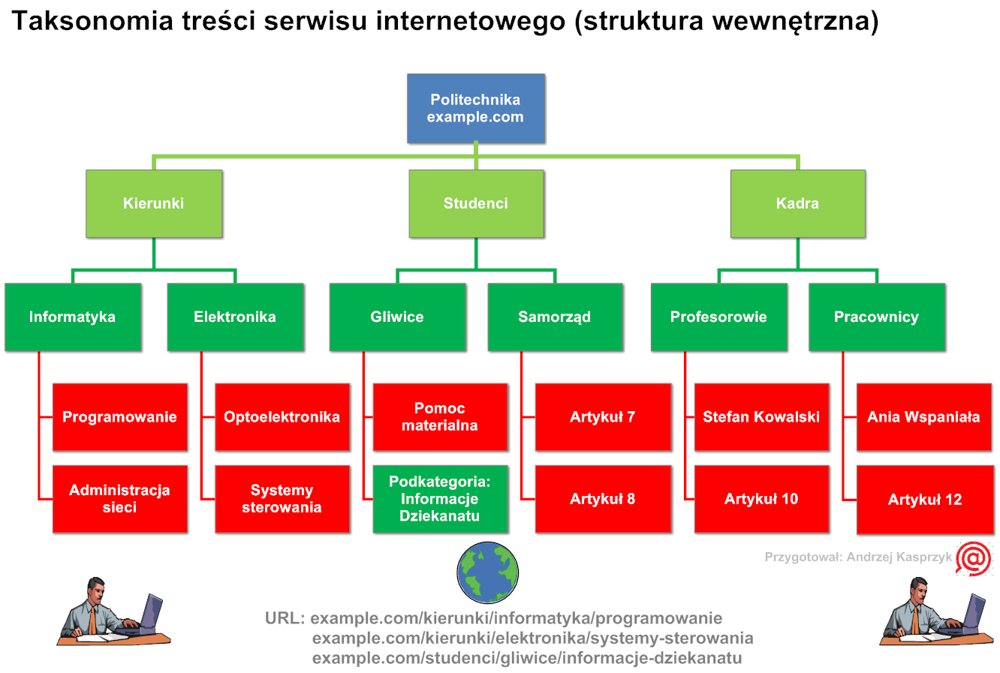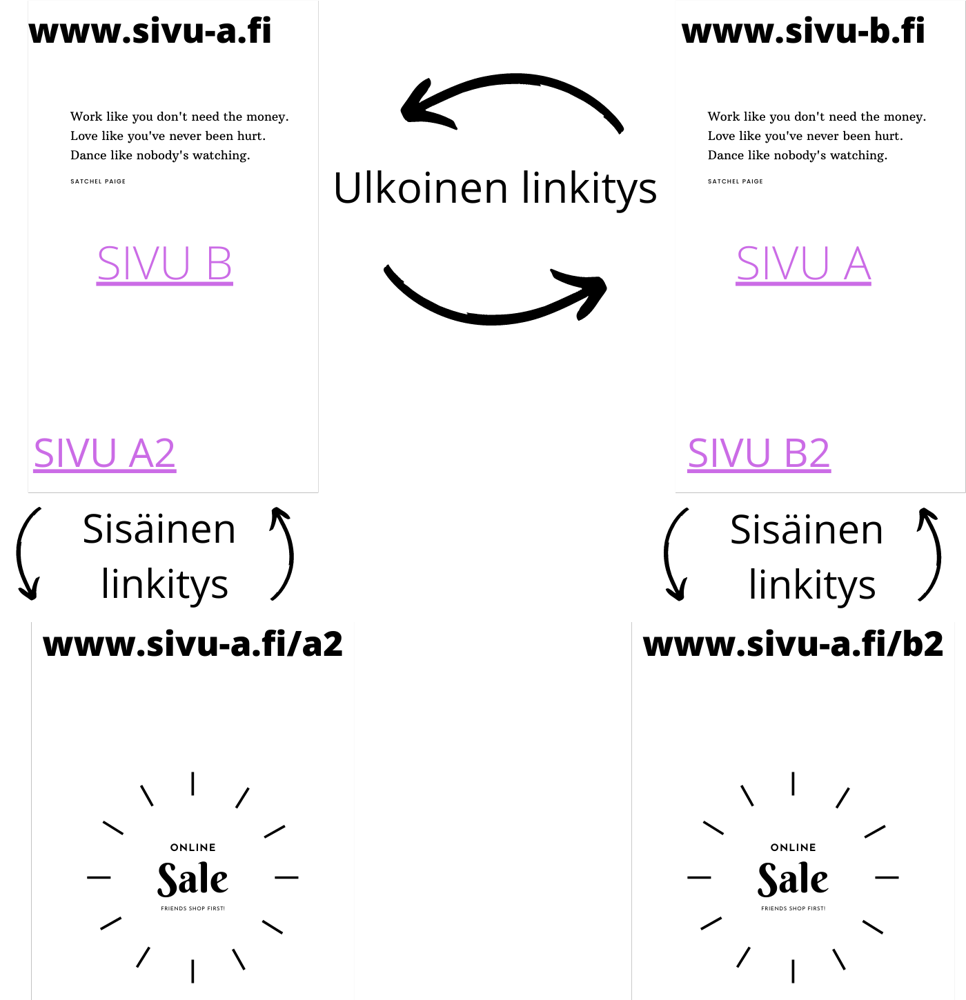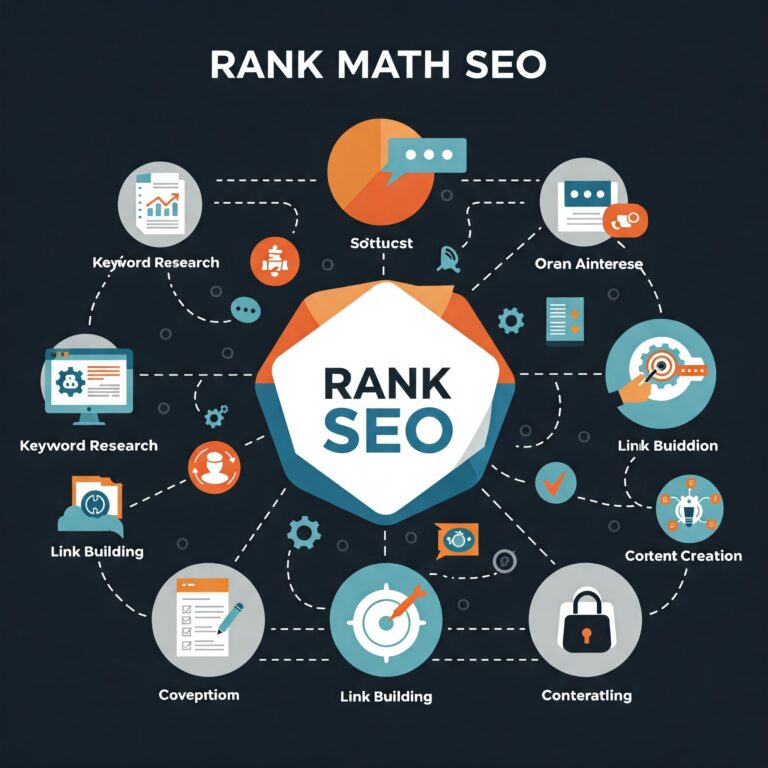
On Page and Off Page SEO: Advanced Strategies for E-commerce and Local Businesses
Advanced SEO requires a holistic approach. On-page SEO involves optimizing elements on your site – from content and HTML to site performance – to signal relevance and quality. To build authority, off-page SEO focuses on external signals like backlinks, brand mentions, social presence, and local citations. For example, Backlinko highlights that internal linking is “HUGE for SEO” and recommends linking from your most authoritative pages to key target pages (On-Page SEO: The Definitive Guide + FREE Template (2025)) (On-Page SEO: The Definitive Guide + FREE Template (2025)). Likewise, external links to high-quality related sites can boost trust – one experiment showed sites linking out to authoritative domains (like Oxford) outperformed those without outgoing links (On-Page SEO: The Definitive Guide + FREE Template (2025)). The sections below dive into both on-page and off-page tactics, with examples and tools relevant to e-commerce stores and local businesses.
On-Page SEO Strategies
Keyword & Content Optimization: Use advanced keyword research to identify high-intent terms (e.g., product + “buy”, service + “near me”). Incorporate primary and related keywords naturally in titles, headers, meta descriptions, body text, and image alt text. High-quality, comprehensive content is essential – e-commerce product pages should include detailed descriptions, specs, FAQs, and policies so users find all the needed info onsite. (For example, one guide advises including shipping costs, reviews, and returns policy on product pages to satisfy customer queries (A Guide to On-Page SEO for Ecommerce Websites).) Leverage semantic SEO and LSI keywords to cover topic depth. Local businesses should optimize pages for geographic modifiers (“plumber in Denver”) and include unique local content like city-specific service pages, about-us details, and testimonials.
Technical Performance & UX: Site speed and user experience are critical on-page factors. Optimize images, use modern image formats (WebP/AVIF), enable compression and caching, and streamline code. The screenshot below (from a technical SEO audit) illustrates site load times on desktop vs. mobile – a slow 13-second mobile load (on the right) would severely hurt rankings. Regular technical audits with tools like Google PageSpeed Insights and Lighthouse ensure Core Web Vitals targets (LCP, FID, CLS) are met. Fast, mobile-responsive design is especially important for local “near me” searches, as 72% of mobile searchers visit a store within 5 miles (Local SEO: The Definitive Guide (2025)).

Figure: Example site audit metric showing page load times (4s desktop vs. 13s mobile). Regularly testing with PageSpeed or Lighthouse helps fix slow-loading pages and optimize Core Web Vitals.
Structured Data (Schema Markup): Adding schema helps Google understand page content and enables rich snippets (star ratings, prices, etc.). For e-commerce sites, use the Product schema to include price, availability, brand, and aggregateRating. Neil Patel notes that “product schema… highlights key information like price and customer reviews” and boosts click-through rates (Boost Your E-Commerce Success with Product Schema). Higher visibility explains that schema “helps search engines understand your content better” and yields rich snippets (showing prices, ratings, etc.) to attract more clicks (E-Commerce SEO Best Practices for 2025 (Guaranteed to Boost Sales)). For example, a product schema JSON-LD might include {"@type":"Product","name":"Coffee Grinder","offers":{"@type":"Offer","price":"299.99","availability":"InStock"},"aggregateRating":{"ratingValue":"4.8","reviewCount":"47"}}. (Tools like Google’s Structured Data Markup Helper or JSON-LD generators simplify this.) Local businesses should use the LocalBusiness schema to mark NAP (name/address/phone), hours, and geo-coordinates. Always test the schema with Google’s Rich Results Test to ensure correctness.
Figure: Example of a site taxonomy (content hierarchy). A clear, hierarchical structure (green boxes for categories, red for subpages) helps distribute authority and makes content easy to navigate. Good site architecture is a foundation of on-page SEO.

Site Architecture & Internal Linking: A logical site hierarchy and strategic internal links are vital. Use silo structures or clear taxonomies so related pages link together. For instance, group e-commerce products into well-named categories and interlink products within a category. Backlinko emphasizes “link from high-authority pages to pages that need a boost” (On-Page SEO: The Definitive Guide + FREE Template (2025)) (On-Page SEO: The Definitive Guide + FREE Template (2025)). In practice, identify your most-linked pages (via tools like Semrush or Ahrefs) and add internal links from those pages to your new or priority pages. This passes page rank effectively. Use keyword-rich anchor text where relevant (but keep it natural). Templates and CMS features can help at scale – for example, a templated footer can include site-wide links to important pages. The BeinSEO guide suggests using standardized templates and SEO plugins to automate on-page elements like meta tags, sitemaps, and structured data across large sites (Advanced On-Page SEO Techniques for 2023). For on-page SEO at scale, regularly crawl with Screaming Frog or Sitebulb to audit titles, headers, and duplicate content, fixing issues promptly.
On-Page UX & Engagement: Advanced SEO also considers user experience: ensure your pages are easy to read and interact with. Use clear headings (H1–H6), bullet lists, and multimedia (images, videos) to break up text. Optimize images with descriptive alt text (supporting keyword strategy). Ensure mobile-friendliness with responsive design. Enhance dwell time with engaging elements: e.g., use a sticky “FAQ” section on product pages, implement live chat, or use accordions for extra details. Track user engagement metrics (bounce rate, time on page) via Google Analytics or Hotjar to find pages needing improvement. Focus on relevance and value – Google’s algorithms increasingly reward pages satisfying user intent. As BeinSEO notes, as search evolves (voice, mobile), “focusing on user intent and providing valuable, relevant content will be paramount” (Advanced On-Page SEO Techniques for 2023).
Recommended On-Page SEO Tools:
- Google Search Console – monitor keyword performance, index status, and Core Web Vitals.
- Lighthouse/PageSpeed Insights – audit site speed and UX issues.
- Screaming Frog/Sitebulb – crawl site for meta tags, broken links, and duplicate content.
- SurferSEO/Clearscope/MarketMuse – analyze content gaps and optimize topically.
- Yoast SEO or RankMath – WordPress plugins to enforce on-page best practices.
- GTmetrix – detailed performance reports for site speed.
Off-Page SEO Strategies
- E-Commerce On-Page Example: An online retailer optimized its product pages by adding rich, unique descriptions and review schema. For instance, a “wireless headset” page included bullet-point specs, a Q&A section, and JSON-LD markup for price and star-rating. As Neil Patel notes, these enhancements “make your listing stand out” and improve click-throughs (Boost Your E-Commerce Success with Product Schema). By also speeding up mobile load time (resizing images, using a CDN), the site saw higher engagement and sales. Off-page, the store built links by publishing a shareable industry report. Within weeks, the report ranked on page 1, earning natural backlinks (Off-Page SEO: The Complete Guide for 2025).
- Local Business On-Page Example: A local bakery created a page for each town it serves, each featuring that town’s name in titles and throughout the content. They structured each page with schema (LocalBusiness schema, including opening hours and menu items). Additionally, they maintained a blog with community event posts (optimized with local keywords). This clear site structure and local keyword usage helped Google recognize relevance to “town-name bakery”. On-page NAP consistency (also present on every page footer) ensured Google’s Business Profile matched exactly (Local SEO: The Definitive Guide (2025)).
- E-Commerce Off-Page Example: A gadget e-shop used broken-link building: they found outdated gadget-review pages on tech blogs (via Ahrefs/Semrush) and reached out to those sites offering their own updated guide. They also ran a digital PR campaign by pitching their gadget to YouTubers and tech journalists. The result was high-authority backlinks from tech sites and YouTube video mentions, significantly raising their domain authority. Socially, they posted infographics on Instagram, which got shared by tech influencers, indirectly boosting brand searches.
- Local Business Off-Page Example: A neighborhood plumbing company focused on local links. They joined their town’s Chamber of Commerce (earning a backlink from the chamber site) and sponsored a local Little League (link from the league’s sponsor page). They also ensured profiles on Yelp, Facebook, and industry directories were complete. BrightLocal emphasizes directories and review sites as “ticket-to-entry” links (13 Local Link Building Tactics to Boost Your Visibility – BrightLocal). Their active Google Reviews (always responding) and local press mentions (e.g., a quoted plumbing safety tip in a local newspaper) improved trust. After these efforts, the company began appearing in the 3-pack for “plumber near me” searches.
High-Quality Link Building: Backlinks remain the backbone of off-page SEO. However, focus on relevance and authority rather than sheer quantity (Off-Page SEO: The Complete Guide for 2025). Pursue links from sites in your niche or region: for an e-commerce electronics store, that could be tech blogs, review sites, or manufacturer partner pages; for a local restaurant, local food bloggers, and city tourism sites. Advanced tactics include “be a data source”: create compelling industry studies or statistics and earn citations. Backlinko’s Brian Dean describes how creating an “email marketing stats” post earned many organic links because people cited the specific stat (Off-Page SEO: The Complete Guide for 2025). Similarly, use broken content/links outreach: find popular but now-deleted articles in your industry (using a tool like Semrush Site Audit) and reach out offering your updated content as a replacement (Off-Page SEO: The Complete Guide for 2025). “Broken link building” like this leverages existing link equity. Content-driven approaches (like infographics, interactive tools, or in-depth guides) also attract natural backlinks and social shares.
Digital PR & Content Marketing: Actively promote your content and brand. Engage in digital PR campaigns (press releases, expert interviews, HARO) to get mentions in news and industry publications. Reach out to journalists with data or stories to earn authoritative coverage. Collaborate with influencers or complementary businesses for co-marketing content (e.g. a guest post on a popular blog). Send products to relevant reviewers. Each mention (even without a link) can boost brand awareness and lead to earned links. For example, an e-commerce fashion brand might pitch a style guide to a major lifestyle magazine, or a local cafe might sponsor a community event and get coverage on the city’s news site. According to Backlinko, while Google says social signals don’t directly boost rankings (Off-Page SEO: The Complete Guide for 2025), social sharing amplifies visibility – “social sharing can indirectly help your off-page SEO” by exposing your brand to new audiences (Off-Page SEO: The Complete Guide for 2025). Real engagement (likes, shares, comments) doesn’t count for rank, but a strong social presence can lead to more branded searches and links from blogs.
Brand Mentions & E‑A‑T: Build your brand’s credibility. Even unlinked brand mentions (e.g. news stories, podcasts) contribute to off-page authority. Encourage reviews on Google, Yelp, Facebook and industry-specific sites – ratings factor into local SEO rankings. Backlinko’s Local SEO guide highlights that Google uses review sentiment and keyword mentions in reviews as ranking signals (Local SEO: The Definitive Guide (2025)). Maintain a positive review profile: respond to reviews (both good and bad) on your Google Business Profile (GBP) – consistent name/address/phone (NAP) data and active engagement (replying to reviews) are crucial (Local SEO: The Definitive Guide (2025)). This also feeds Google’s E‑E‑A‑T algorithm: authority and trust signals (mentions in credible media, positive reviews) strengthen your expertise and trustworthiness (Off-Page SEO: The Complete Guide for 2025). For e-commerce, encourage product reviews on-site (which can be marked up with Review schema). For local businesses, replying to Google and Yelp reviews shows Google you’re active and trustworthy.
Local Citations & Partnerships (Local Off-Page SEO): Local businesses must build local signals. Ensure your business is listed consistently on major directories (Google Business Profile, Bing Places, Apple Maps) and niche/local sites (Yelp, Yellow Pages, industry associations). BrightLocal notes that “local links from relevant sources are a key ranking factor” and building awareness is an often-overlooked benefit of local linking (13 Local Link Building Tactics to Boost Your Visibility – BrightLocal) (13 Local Link Building Tactics to Boost Your Visibility – BrightLocal). Getting listed in local business directories and review sites is the “ticket-to-entry” for local SEO (13 Local Link Building Tactics to Boost Your Visibility – BrightLocal). Examples include city directories, local Chamber of Commerce sites, or local newspapers’ business guides. For instance, a dentist could secure links from a regional health directory or the local tourism board listing. Sponsorship links (e.g., sponsoring a Little League team and getting a link on their site) can also be valuable: BrightLocal highlights that a link from a chamber of commerce can target your local customer base and drive qualified visibility (13 Local Link Building Tactics to Boost Your Visibility – BrightLocal). Citation consistency is critical: Backlinko stresses that GBP info must match website NAP and all citations exactly (Local SEO: The Definitive Guide (2025)). Mismatched names or addresses can confuse Google. For multi-location businesses, create separate location landing pages (with unique content and local keywords on each) and separate Google Business Profiles – OHSO Brewery did this for six locations and dominated the map pack (Local SEO: The Definitive Guide (2025)) (Local SEO: The Definitive Guide (2025)).
Figure: Illustration of linking structure. “Sisäinen linkitys” (internal linking) and “Ulkoinen linkitys” (external linking) are shown between two example sites. High-quality external backlinks (e.g., top arrows) and smart internal links (bottom arrows) together distribute authority across pages and domains, boosting SEO.

Social & Content Distribution: While social media likes aren’t a direct Google ranking factor, use social channels to promote content and engage your audience. More eyeballs can lead to natural links and branded searches. For example, sharing a viral blog post on LinkedIn or Instagram may catch an influencer’s eye, who then links to it. According to Backlinko, having a popular social presence can itself be a brand signal (Off-Page SEO: The Complete Guide for 2025). Encourage employees and customers to share content. You can also use platforms like Quora or Reddit (with caution) to build indirect awareness by genuinely helping users with answers and linking back to your content when relevant.
Recommended Off-Page SEO Tools:
- Ahrefs / Majestic / Moz – comprehensive backlink analysis and competitor link research.
- Semrush Backlink Analytics – to find broken links on competitor sites and conduct broken-link outreach.
- BuzzSumo / Google Alerts – for content discovery and monitoring brand mentions.
- HARO / Muck Rack – connect with journalists for PR link opportunities.
- Local SEO Tools (BrightLocal, Whitespark) – find citation gaps and manage local listings.
- Google Business Profile – not a “tool” per se, but regularly update posts/offers and use insights.
- Social Listening (TweetDeck, Hootsuite) – monitor when your brand or products are mentioned.
Real-World Use Cases
In summary, advanced SEO means systematically improving both on-site signals (fast, structured, user-focused content) and off-site authority (through strategic linking, branding, and local trust signals). By applying these tactics together – e-commerce sites leveraging product schema and technical fixes, and local businesses building citations and GBP authority – SEO professionals can achieve strong, sustainable rankings.
Sources:
- On-Page SEO: The Definitive Guide + FREE Template (2025)
- On-Page SEO: The Definitive Guide + FREE Template (2025)
- E-Commerce SEO Best Practices for 2025
- Guaranteed to Boost Sales
- Off-Page SEO: The Complete Guide for 2025
- Off-Page SEO: The Complete Guide for 2025
- 13 Local Link Building Tactics to Boost Your Visibility – BrightLocal
- Local SEO: The Definitive Guide (2025)
- Local SEO: The Definitive Guide (2025)
- Boost Your E-Commerce Success with Product Schema
You can read about the best SEO Plugin Offer included.



